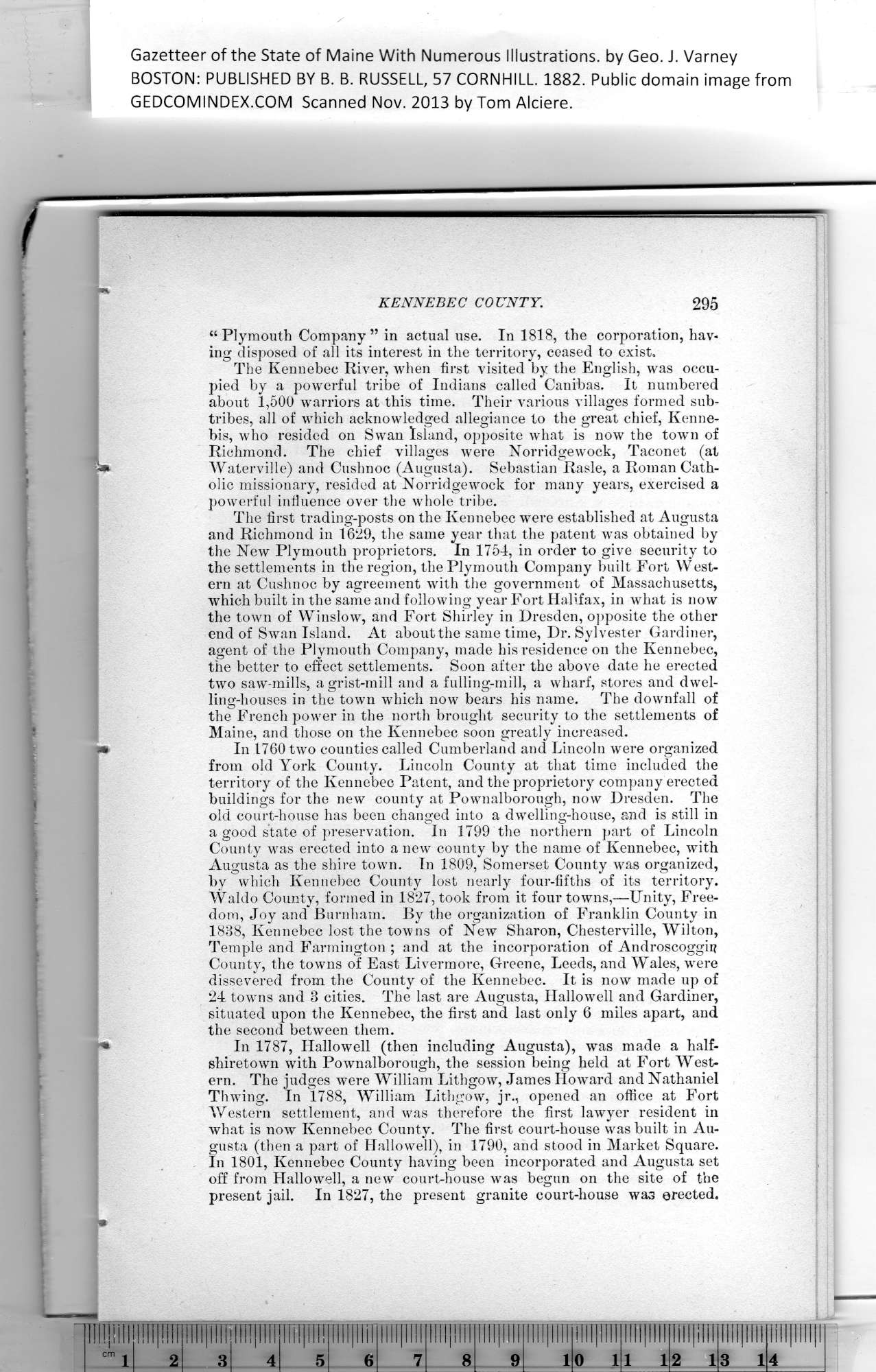|
Gazetteer of the State of Maine With Numerous Illustrations, by Geo. J. Varney
BOSTON: PUBLISHED BY B. B. RUSSELL, 57 CORNHILL. 1882. Public domain image from
KENNEBEC COUNTY. 295
“Plymouth Company” in actual use. In 1818, the corporation, hav-
ing disposed of all its interest in the territory, ceased to exist.
The Kennebec River, when first visited by the English, was occu-
pied by a powerful tribe of Indians called Canibas. It numbered
about 1,500 warriors at this time. Their various villages formed sub-
tribes, all of which acknowledged allegiance to the great chief, Kenne-
bis, who resided on Swan Island, opposite what is now the town of
Richmond. The chief villages were Norridgewock, Taconet (at
Waterville) and Cushnoc (Augusta). Sebastian Rasle, a Roman Cath-
olic missionary, resided at Norridgewock for many years, exercised a
powerful influence over the whole tribe.
The first trading-posts on the Kennebec were established at Augusta
and Richmond in 1629, the same year that the patent was obtained by
the New Plymouth proprietors. In 1754, in order to give security to
the settlements in the region, the Plymouth Company built Fort West-
ern at Cushnoc by agreement with the government of Massachusetts,
which built in the same and following year Fort Halifax, in what is now
the town of Winslow, and Fort Shirley in Dresden, opposite the other
end of Swan Island. At about the same time, Dr. Sylvester Gardiner,
agent of the Plymouth Company, made his residence on the Kennebec,
the better to effect settlements. Soon after the above date he erected
two saw-mills, a grist-mill and a fulling-mill, a wharf, stores and dwel-
ling-houses in the town which now bears his name. The downfall of
the French power in the north brought security to the settlements of
Maine, and those on the Kennebec soon greatly increased.
In 1760 two counties called Cumberland and Lincoln were organized
from old York County. Lincoln County at that time included the
territory of the Kennebec Patent, and the proprietory company erected
buildings for the new county at Pownalborough, now Dresden. The
old court-house has been changed into a dwelling-house, and is still in
a good state of preservation. In 1799 the northern part of Lincoln
County was erected into a new county by the name of Kennebec, with
Augusta as the shire town. In 1809, Somerset County was organized,
by which Kennebec County lost nearly four-fifths of its territory.
Waldo County, formed in 1827, took from it four towns,—Unity, Free-
dom, Joy and Burnham. By the organization of Franklin County in
1838, Kennebec lost the towns of New Sharon, Chesterville, Wilton,
Temple and Farmington ; and at the incorporation of Androscoggin
County, the towns of East Livermore, Greene, Leeds, and Wales, were
dissevered from the County of the Kennebec. It is now made up of
24 towns and 3 cities. The last are Augusta, Hallowell and Gardiner,
situated upon the Kennebec, the first and last only 6 miles apart, and
the second between them.
In 1787, Hallowell (then including Augusta), was made a half-
shiretown with Pownalborough, the session being held at Fort West-
ern. The judges were William Lithgow, James Howard and Nathaniel
Thwing. In 1788, William Lithgow, jr., opened an office at Fort
Western settlement, and was therefore the first lawyer resident in
what is now Kennebec County. The first court-house was built in Au-
gusta (then a part of Hallowell), in 1790, and stood in Market Square.
In 1801, Kennebec County having been incorporated and Augusta set
off from Hallowell, a new court-house was begun on the site of the
present jail. In 1827, the present granite court-house was erected.
PREVIOUS PAGE ... NEXT PAGE
This page was written in HTML using a program written in Python 3.2
|
